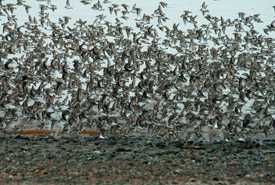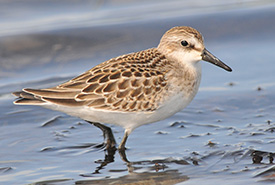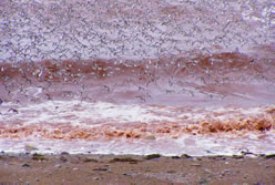The incredible migration at Johnson's Mills Shorebird Reserve

Semipalmated sandpiper (Photo by NCC)
From late July to mid-August, the scene at the Nature Conservancy of Canada’s (NCC’s) Johnson’s Mills Shorebird Reserve on the Bay of Fundy in New Brunswick is awe-inspiring. There are days when as many as 140,000 semipalmated sandpipers nestle together along the mudflats, eating, resting and gathering strength for the next stage in their epic migration journey.
Born in July, semipalmated sandpipers start their life on the tundra of the Canadian sub-Arctic near Hudson’s Bay. It’s incredible that these tiny birds can survive in a harsh climate. Even more baffling is that once the eggs hatch, the chicks are never fed by their parents and are left to fend for themselves.

Semipalmated sandpiper (Photo by Denis Doucet)
At five or six weeks old, semipalmated sandpipers begin their 10,000-kilometre flight to their wintering grounds in South America. They make only one stop during this southward flight: to refuel in the Bay of Fundy, between Nova Scotia and New Brunswick — at Johnson’s Mills. During this three-week stopover, the 20-gram birds (the weight of a large strawberry) must feed and rest as much as possible to ensure they double their weight. The sandpipers consume huge amounts of mud shrimp and other delicacies: the equivalent in human terms would be 150 cheeseburgers a day!
Sounds easy right? It isn’t. Whenever the birds are disturbed, they take flight, burning precious calories they need to conserve for the migration.
That’s where NCC staff come in.

Shorebirds at Johnson's Mills, NB (Photo by NCC)
During the stopover season, we make sure the shorebirds are able to rest and feed as much as possible, while being disturbed as little as possible. At Johnson’s Mills Shorebird Interpretive Centre, NCC staff provide visitors with binoculars and telescopes and guide them to the observation deck, which looks out onto the beach. Staff also educate visitors about why they need to stay on the deck and keep a safe distance. The less the birds are disturbed, the fewer calories they burn, and the higher the success rate for sandpipers to survive their difficult migration south.
This year, on World Shorebirds Day (September 6), NCC announced the protection of an additional 32 acres (13 hectares) of critically important coastal habitat at Johnson’s Mills. We now protect more than 562 acres (227 hectares) here at this key migratory stopover point, recognized by Western Hemisphere Shorebird Reserve Network (WHSRN) as a Site of Hemispheric Importance.
It’s imperative that NCC’s conservation work in this area continues. Although the global population of semipalmated sandpipers is seemingly high (more than one million), it has actually declined seriously over the last 40 years. The future of its population is uncertain, with these birds facing threats from climate change, hunting in South America and habitat loss, all of which make the habitat protection NCC does even more vital.
After managing the Shorebird Interpretive Centre for the past six years, I’m proud to say that NCC and our supporters are making a real difference locally and globally for the magnificent semipalmated sandpiper, along with many other species of shorebirds.
Over the past summer, more than 3,000 visitors from all over Canada and the world stood on NCC's observation deck, completely awe-inspired by one of the most incredible nature destinations in the country. I welcome you to add a visit to Johnson’s Mills to your bucket list, and come and see the wonder of the sandpiper migration for yourself.
Missed the birds? See a time-lapse of this year's migration at Johnson's Mills below:
Johnson’s Mills Shorebird Interpretive Centre is one of the Nature Conservancy of Canada’s properties featured in Nature Destinations, a program that invites you to take a journey through some of the greatest examples of our country’s natural areas and to connect with nature. Visit naturedestinations.ca.


